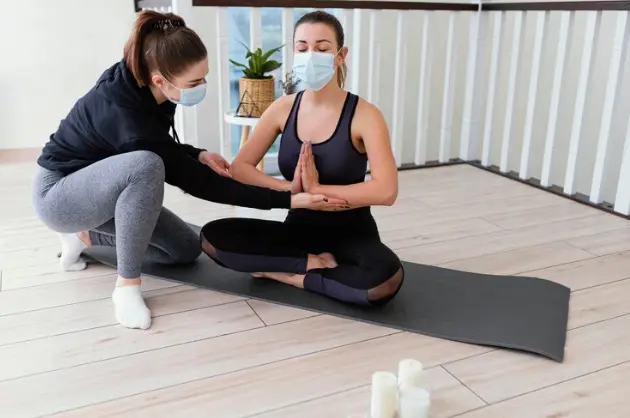Asthma is a chronic lung condition that causes airways to narrow and inflame, leading to symptoms such as wheezing and chest tightness. While asthma can be controlled with medication, incorporating yoga into your routine can also help to ease and prevent asthma attacks.
Yoga consists of physical stances and repetitive breathing movements designed to unite the body, mind, and soul. Here are some advantages of yoga for asthma patients:
Improved Breath Control
Breathing is one of the most important aspects of our lives. Any disorder of breath can hurt the body. Asthma is a breathing disorder that causes wheezing and difficulty in taking breath. Yoga is a breathing exercise that helps people overcome this problem and breathe normally again. Buy some effective inhalers online at Specialitymedz Pharmacy.
In a recent study, 24 asthmatic patients were divided into two groups. One group was given medication while the other practiced yoga. After four weeks, the yoga group experienced a reduction in day and night asthma attacks along with a reduction in the use of medication and an improvement in peak expiratory flow rate. The control group, on the other hand, experienced no such benefits.
Yoga helps increase the awareness of the breath, slows the respiratory rate, and promotes calmness and stress management. These are all factors that help reduce the occurrence and severity of asthma attacks.
Many yoga poses focus on the breath, such as the Badhakonasana (Butterfly Pose) and Poorvottanasana (Upward Plank Pose). These postures improve blood circulation and increase oxygen supply to the lungs, which helps prevent asthma flare-ups. Moreover, the final pose in each session of yoga, Savasana (Corpse Pose), brings the body into a meditative state and relaxes the muscles. This is especially beneficial for asthmatics because it can help them breathe naturally and eliminate the need for medications during an attack.
Reduced Stress
Yoga’s emphasis on breathing exercises and meditation can help calm the mind. It’s also been shown to reduce stress. Stress is a major trigger for asthma, so anything that can lower stress levels is beneficial to people with asthma.
A study found that a 90-day practice of a yoga module had a significant positive impact on quality of life, anxiety and depression, and pulmonary function in young adults with mild asthma. While yoga is not a medically proven treatment for acute symptoms, it can be added to an existing asthma action plan as an add-on therapy.
People with asthma who are considering incorporating yoga into their lifestyle should always consult their doctor to make sure the activity is safe and appropriate for them. It’s a good idea to use a rescue inhaler as prescribed by your doctor and to practice the exercise gently, so as not to overexert yourself.
Asthma is a complex condition that affects both the respiratory and musculoskeletal systems. It can be triggered by many different things, from pollen particles to dust to getting up or down the stairs. People with asthma can feel like they’re constantly fighting for breath, which can be extremely frustrating. In addition, they can suffer from fatigue and anxiety. All of these issues can be exacerbated by stress. The benefits of yoga include improved lung capacity, increased flexibility and better balance, which can all help to relieve the symptoms of asthma.
Increased Muscle Tone
The practice of yoga provides a number of benefits that can help asthma sufferers live more comfortable lives. Not only does it relieve stress, but it also improves breathing and lung function. It can even decrease the frequency of asthma attacks. As a result, people with asthma should consider incorporating yoga into their treatment plan.
Yoga involves controlled, conscious movements that encourage proper posture and breathing. It also promotes relaxation, which can help to relieve stress and anxiety levels that can exacerbate asthma symptoms. It also helps to strengthen the muscles around the lungs, which can improve lung capacity and increase breathability.
Studies have shown that patients with asthma who regularly practice yoga experience fewer asthma attacks and use less medication. In addition, they have higher peak expiratory flow rates (PEFR). The random-effect summary SMD was 0.73 (95% CI 0.36 to 1.09; 7 studies; 433 participants; P 0.0001), and the fixed-effect SMD was 0.20 (95% CI 0.07 to 0.27; 3 studies; 125 participants; P 0.001), respectively. Pink inhaler for asthma also effectively treats patients.
Several poses can benefit asthma sufferers, including the Badhakonasana (Butterfly Pose), which stimulates and improves respiratory function and the Poorvottanasana (Upward Plank Pose), which stretches the shoulders, wrists, arms, back, and spine, while improving respiration. As a final pose, it is recommended to finish the session with the Shavasana (Corpse Pose), which promotes relaxation and helps relieve asthma symptoms by reducing anxiety and stress levels.
Improved Sleep
Asthma patients are prone to insomnia because of the constant coughing and wheezing. Yoga helps them improve their sleep quality and prevents the occurrence of asthma attacks. It is also effective in improving their lung health and can help them lead a more active life without any restrictions due to their condition.
According to studies, yoga has a significant impact on the psycho-somatic imbalance present in most asthmatic individuals. It stabilizes and reduces the excitability of the nervous system, which decreases efferent vagal reactivity that has been recognized as a major factor in the progression of asthma.
As a result, people with asthma are less likely to experience symptoms like shortness of breath and wheezing when they perform normal activities. Moreover, incorporating yoga into their lifestyle makes it easier for them to manage their daily routine. It also helps them improve their overall wellness by reducing stress, supporting healthy habits, and improving mental/emotional health, sleep, and balance.
Asthma can greatly affect a person’s quality of life, making it difficult to carry out even the simplest tasks. Fortunately, there are various ways to relieve this chronic respiratory disorder, including medications and other treatments. However, many people are not aware that they can find relief from this condition by adding a regular practice of yoga to their regimen. This activity strengthens the muscles and increases flexibility while fostering a connection between the body and the breath.





